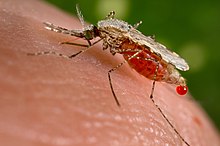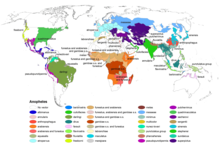Anopheles [1] is a genus of mosquito.[2]
| Anopheles | |
|---|---|

| |
| Anopheles stephensi | |
| Scientific classification | |
| Domain: | Eukaryota |
| Kingdom: | Animalia |
| Phylum: | Arthropoda |
| Class: | Insecta |
| Order: | Diptera |
| Family: | Culicidae |
| Subfamily: | Anophelinae |
| Genus: | Anopheles Meigen 1818 |
| Species | |
|
For a full description, see section Systematics and the main article: Taxonomy of Anopheles
| |

| |
| Anopheles range map | |
There about 460 species, and over 100 can transmit human malaria. Only 30–40 commonly transmit parasites of the genus Plasmodium, which causes human malaria in endemic areas. Anopheles gambiae is one of the best known, because it transmits the most dangerous malarial parasite species (to humans) – Plasmodium falciparum.
Some species of Anopheles are vectors for canine heartworm Dirofilaria immitis, filariasis, and viruses such as one that causes O'nyong'nyong fever. Brain tumors sometimes occur in malaria sufferers, which suggests that Anopheles might transmit a virus or other agent which could cause a brain tumor.[3]
Mosquitoes in other genera (Aedes, Culex, Culiseta, Haemagogus and Ochlerotatus) can also be vectors of disease agents, but not malaria.